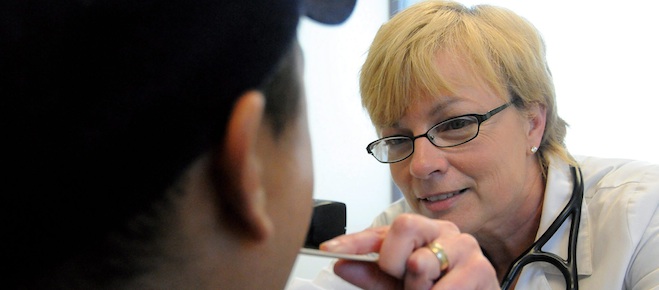Does how we pay health-care workers affect how they treat us?
Science-ish looks at the evidence on pay models and health care
Nurse practitioner Nancy Giammarella checks the throat of Henry Moreno at the Health Department in Dalton, Ga. on April 14, 2011. The United States faces a growing shortage of primary care physicians, those who specialize in family practice, internal medicine, pediatrics and obstetrics/gynecology. And smaller communities, such as in Whitfield and Murray counties, are getting hit hardest. Last year, the Association of American Medical Colleges predicted a shortage of 45,000 primary care physicians nationwide by 2020. Experts say better pay and better hours are drawing medical students away from primary care to other specialties. (AP Photo/The Daily Citizen, Matt Hamilton)
Share

At a meeting of doctors in B.C. last week, Science-ish listened in as a couple of surgeons complained about slow turnovers between procedures in their operating rooms. These Vancouver physicians said they’ve had to send anxious patients home who were scheduled for surgeries or wile away coffee breaks waiting for their theatres to be prepped. The reason for the slowness? Money—or so they believed. While they are paid on a fee-for-service basis, the cleaners and nurses who prepped the OR are salaried. The discord in payment models seemed to cause a discord in the OR: The doctors felt the salaried hospital workers had little incentive to move quickly, while they did. Patients’ lives hung in the balance.
Science-ish ran the anecdote by health-care analyst Steven Lewis, and he got right to the heart of the tensions that can flare among groups of health professionals. “That’s hugely disrespectful to nurses and housekeepers to make the assumption that the only thing that would motivate them to work efficiently and effectively is to be on the same the fee-for-service treadmill as those physicians,” he said.
But was there a grain of truth to the story? Does how we pay health-care workers impact patient care?
According to Dr. Rick Glazier, senior scientist at the Institute for Clinical Evaluative Sciences, Canadian doctors are among the only health professionals who are still paid predominantly on fee-for-service but the evidence suggests there’s actually no “best” way to compensate them: every fee model has its costs and rewards. “When they’re on salary, the risk is shirking or not working hard,” he said. Yet there are examples like the Mayo Clinic, an international model for health-care excellence, where everyone is paid a salary, and the evidence shows salaries are associated with longer consultations and more preventive care compared with fee-for-service.
Capitation, where doctors get a fixed amount per patient enrolled in their practice, is another popular remuneration model. While it makes controlling costs simpler, “The risk is cream skimming or cherry picking, where you only want to look after healthy patients who don’t take as much time.” In a report Dr. Glazier released in March, looking at primary-care models in Ontario—including salaries, fee-for-service and capitation—he found that different styles of compensation are correlated with different patient populations. Doctors on capitation served more advantaged—perhaps cherry picked—patients, while Community Health Centres where doctors are salaried looked after disadvantaged and sicker folks, including newcomers and those on social assistance.
One thing we know about fee-for-service is that it rewards volume: more visits, services, and procedures. A number of studies have documented this association, including this recent systematic review. Of course, the risk here is over-servicing and more is not necessarily better when it comes to health. Plus, as Dr. Glazier noted, it’s not necessarily the best model for health-care transformation. “If you want to take time to organize care and improve care, that’s not attractive to fee-for-service doctors because they’re losing money when they’re not seeing patients.”
Fee-for-service is still the dominant pay model in Canada, with over 70 per cent of doctors remunerated this way. Right now, the landscape is changing. Younger doctors don’t want to work in the solo practices associated with this type of pay, and some say this is a good thing for health care—and relations among health professionals. “Physicians are paid this way for historical reasons; it’s what they bargained for when medicare was implemented,” said Lewis. But we need health professionals to take “a more coordinated approach” to funding and payment. “It’s divisive and unhelpful that physicians are paid one way, and everyone else is paid another. It gets in the way of team work, and the separateness is a huge barrier to system integration and to high quality care.”
Science-ish is a joint project of Maclean’s, the Medical Post and the McMaster Health Forum. Julia Belluz is the associate editor at the Medical Post. Got a tip? Seen something that’s Science-ish? Message her at [email protected] or on Twitter @juliaoftoronto